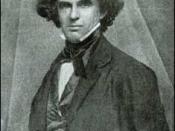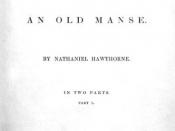Goodman's Loss of Faith
Nathaniel Hawthorn's short story, "Young Goodman Brown" is allegorical; the characters and objects in the story represent abstract ideas. The evil in Brown's world is frequently represented by some object, person, or event in the short story. The symbols of evil guide the story along and show the reader how Brown loses his faith. Hawthorn uses symbolism to illustrate the story of a young man who reluctantly departs from his world of innocence to realize the widespread evil that exists within his world.
In the beginning of the story, Hawthorne uses the names of the characters as symbols that show Brown's initial innocence, soon to be abandoned. The first two characters introduced in the story are Young Goodman Brown, and his wife, Faith. Young Goodman's youth and good nature are symbolized by his name; his character, "represents the young person's introduction into human ways.
It is important that his innocence should derive from his youth" (Tharpe 76). Brown's youth reveals how uncorrupted and innocent he is in the beginning of the story. Goodman's name also tells the reader that he is a good man. With this, the reader can safely assume that he is loving and faithful to his wife, Faith. In introducing Goodman's wife, Hawthorne writes, "Faith, as the wife was aptly named" (Hawthorne 341). This portrays Faith as Goodman's actual faith and their marriage shows how he clings to faith in good within the world. The pink ribbon worn in Faith's hair represents, "an emblem of heavenly faith" (Fogle 24). It symbolizes Faith's innocence that she has, and needs, in order to represent Brown's faith. The symbolism of these two characters shows how Goodman's faith comes from his innocence which Hawthorne has now set up to show how easily it can be...



Thanks for the help
thanks, for the driection in writing my own paper.
2 out of 2 people found this comment useful.